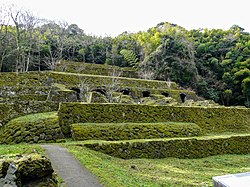Iwami Ginzan Silver Mine
The Iwami Ginzan (石見銀山, “Silver Mountain of Iwami”) was a silver mine in the city of Ōda, Shimane Prefecture.[1] It was the largest silver mine in Japanese history. Iwami Ginzan was active for almost four hundred years. It was discovered in 1526 and closed in 1923.
| UNESCO World Heritage Site | |
|---|---|
 Kamaya Mabu Mine Shaft | |
| Location | Ōda, Shimane Prefecture, Japan |
| Part of | Iwami Ginzan Silver Mine and its Cultural Landscape |
| Criteria | Cultural: (ii), (iii), (v) |
| Reference | 1246bis-001a |
| Inscription | 2007 (31st Session) |
| Extensions | 2010 |
| Area | 317.08 ha (783.5 acres) |
| Coordinates | 35°06′26″N 132°26′15″E / 35.10722°N 132.43750°ECoordinates: 35°06′26″N 132°26′15″E / 35.10722°N 132.43750°E |
Today the mine has become an open-air museum. It was named a World Heritage Site in 2007.[2]
Mine history
Kamiya Jutei, a Japanese merchant, started the mine in 1526. By the early 1600s the mine was producing approximately 38 tons of silver a year. That was one third of the world's production at that time. [3]
Warlords fought over the mine until the Tokugawa Shogunate took control of it in 1600 after the Battle of Sekigahara in 1600. [3] Yamabuki Castle was built in the center of the complex. [3] The mine produced less in the nineteenth century as it had trouble competing with other mines. It closed in 1923.
Position in the economy
Iwami Ginzan Silver Mine was very important in East Asian trade because silver was the main currency. The silver mined at Iwami Ginzan was very high quality. From 17th century, coins made of the silver from the mine were not only one of the basic currencies in Japan but also used in the trade with China, Portugal and the Netherlands.
World Heritage Site
The Japanese Government named the mining town as a Special Preservation District for Groups of Historic Buildings in 1969. The government also applied for it to become a World Heritage Site. The application succeeded in July 2007,[2] although the International Council on Monuments and Sites (ICOSMOS) did not find any "outstanding universal value" of the site.[4]
Iwami Ginzan Silver Mine Media
References
- ↑ Lyman, Benjamin Smith. (1879). Geological Survey of Japan, p. 87.
- ↑ 2.0 2.1 "Iwami picked as World Heritage site," Archived 2013-05-21 at the Wayback MachineThe Yomiuri Shimbun. June 2007.
- ↑ 3.0 3.1 3.2 UNESCO: "Historic Silver Mine of Iwami Ginzan."
- ↑ UNESCO: ICOMOS evaluation of the property
Further reading
- Lyman, Benjamin Smith. (1879). Geological Survey of Japan: Reports of Progress for 1878 and 1879. Tookei: Public Works Department. OCLC: 13342563
Other websites
![]() Media related to Iwami Ginzan Silver Mine at Wikimedia Commons
Media related to Iwami Ginzan Silver Mine at Wikimedia Commons
- Iwami-Ginzan Silver Mine site Archived 2012-04-23 at the Wayback Machine
- Article in UNESCO
- Japan Mint, World Heritage Coin Set Archived 2007-12-06 at the Wayback Machine
![]()





